|
|
|
 |
|
|
|
|
|
|
|
Twyford House
|
|
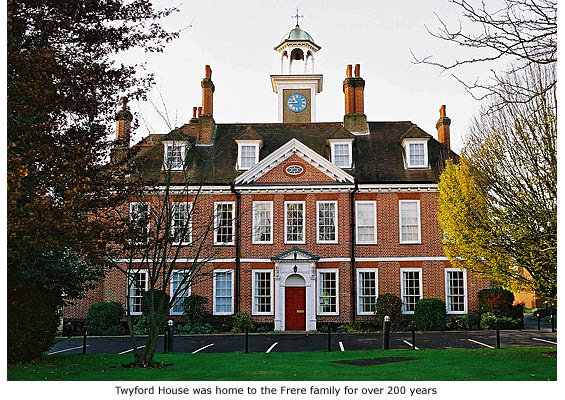
The ancient name Twyford means ‘double ford’, and in this case is derived from two fords once used to cross the river Stort and a small stream that had its origins in Birchanger. Twyford was (and still is) a hamlet of Thorley and today encompasses Twyford Bury, Twyford Lock, Twyford Mill (now residential) and Twyford House; a large Queen Anne style building from the mid to late 1700s that will forever be associated with just two families of Thorley – the Freres and the Rapers.
The name Frere first appeared in local records in the early 13th century but it was the Rapers, a wealthy family of London silk merchants, who became lords of Thorley Manor in the early 1700s, both at Thorley Hall and Twyford House.
|
|
A descendent of the family, John Raper, married Elizabeth, the daughter of William Hale of Twyford House, and in 1762 their daughter, Elizabeth, married a Scottish doctor named William Grant. They had two children, a son, John Peter and a daughter, Elizabeth. John Raper’s brother, Matthew, eventually came to own Twyford House and when he died, childless, he left the property to his niece Elizabeth. She married George Frere in 1806.
Her brother, John Peter Grant, married in 1797 and had a daughter named Elizabeth. She was to die in 1885, but 13 years after her death had a book published called ‘Memoirs of a Highland Lady’. It included her childhood recollections of Twyford House between 1804 and 1806, and mention of her Grandfather who had a small observatory built into Twyford House for use by his brother, Matthew, when he came to stay.
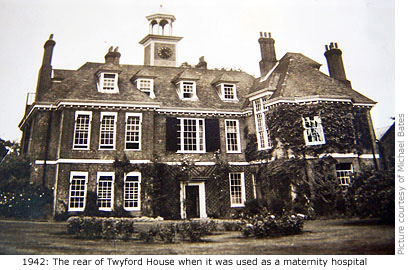 Elizabeth and George Frere had two sons, both of whom would be remembered in later years for their accomplishments on the world stage and locally. Henry Bartle Frere (1815–1884) was to serve a long career in the Civil Service, becoming British colonial administrator of India and high commissioner in South Africa. For his part in the India Mutiny of 1857 he was rewarded with a knighthood and later, in South Africa, was connected with the abolition of the slave trade. He was also instrumental in provoking the Zulu war of 1878 which, though ending in victory for Britain, cost the country dear in lives and money. For his part in it, Sir Henry was officially censured. He died in Surrey in 1884. Elizabeth and George Frere had two sons, both of whom would be remembered in later years for their accomplishments on the world stage and locally. Henry Bartle Frere (1815–1884) was to serve a long career in the Civil Service, becoming British colonial administrator of India and high commissioner in South Africa. For his part in the India Mutiny of 1857 he was rewarded with a knighthood and later, in South Africa, was connected with the abolition of the slave trade. He was also instrumental in provoking the Zulu war of 1878 which, though ending in victory for Britain, cost the country dear in lives and money. For his part in it, Sir Henry was officially censured. He died in Surrey in 1884.
Bartle John Laurie Frere inherited Twyford House from his father, George Frere, in 1854 and went on to become a large land owner in Thorley. Between 1860 and 1871 he rented the house to Arthur Rhodes, brother of Cecil Rhodes, and was instrumental in the creation of Bishop’s Stortford’s Rye Street Hospital. Sadly, he died in 1893 two years before it became a reality (See Guide 7).
|
|
His son, Laurie Frere, then inherited Twyford House and lived there with his wife Maud and their four children; a son, Bartle, and daughters Phillis, Ursula and Beryl. Bartle, the last male heir, was killed in the First World War. Phillis later married and moved to Leatherhead, Surrey, and when their parents died the remaining sisters continued to run the house and estate.
In 1939 or 1940, Twyford House was requisitioned by the War Office for use as a maternity hospital for expectant mothers – mostly single mother evacuees from London's East End. Because of this, Pig Lane was nicknamed Pudding Lane by locals. On arrival in Stortford, expectant mothers were lodged at No 50 Hockerill Street (a house at the top of Hockerill Street) then transferred to Twyford house when the birth was imminent. It is said that a total of 693 babies were born in the house/hospital.
In 1947 the entire Twyford estate was sold to local building contractor, Boyd Gibbins. He turned the house into a hotel, but when the venture failed he then converted it into apartments. When this also failed, financial problems forced him to neglect the property and it rapidly fell into disrepair. In 1985/6, the house was bought by the town's largest building contractor at that time, J.A. Elliott Ltd, the intention being to return the property to listed building status, financed by the building of maisonettes and apartments within the grounds. on completion it was used as the company's headquarters but when the Recession of the late 1980s forced the firm into liquidation in 1991, the house was put in the hands of the Receiver and sold (See Guide 10 – J.A. Elliotts Ltd). It is currently used as private accommodation and offices.
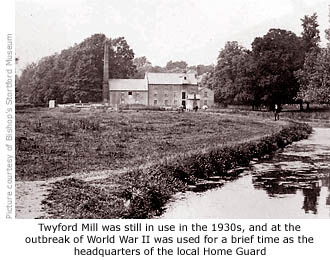 Ursula Frere went to Pretoria, South Africa, in 1946 to do missionary work, and Beryl Frere moved to nearby Latchmore Hall (Hallingbury Road), but on a return visit to see her sister in 1957, Ursula died. In the early 1970s Beryl Frere moved to sheltered accommodation in Dorking, Surrey, near to her sister Phillis, but later returned to Abbeyfield Nursing Home in Cricketfield Lane, Bishop's Stortford, where she died in 1975. She was the last member of the Raper/Grant/Frere family dynasty associated with Twyford House. Ursula Frere went to Pretoria, South Africa, in 1946 to do missionary work, and Beryl Frere moved to nearby Latchmore Hall (Hallingbury Road), but on a return visit to see her sister in 1957, Ursula died. In the early 1970s Beryl Frere moved to sheltered accommodation in Dorking, Surrey, near to her sister Phillis, but later returned to Abbeyfield Nursing Home in Cricketfield Lane, Bishop's Stortford, where she died in 1975. She was the last member of the Raper/Grant/Frere family dynasty associated with Twyford House.
For nine years, John Blake was a part-time valet and butler to the last John Bartle Laurie Frere at Twyford House, and it was Mr Frere, a talented artist, who encouraged Blake to sketch and paint. As a result, many of his accomplished paintings can now be seen hanging on the walls of the local Royal British Legion’s Headquarters in Windhill. Unfortunately Mr Frere’s own efforts were never given a public showing, his entries to the Royal Academy being turned down for 34 consecutive years.
|
|
|
|
Piggotts Manor
|
|
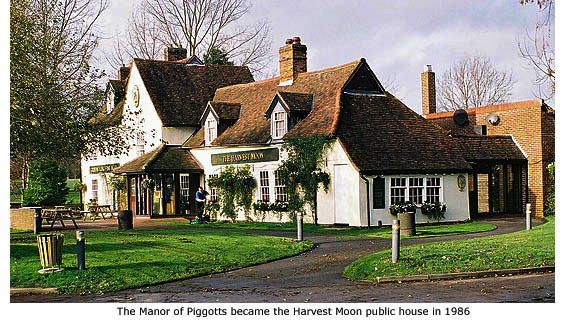
The former Manor of Piggotts lies to the south-west of the town near to the newly developed Friedberg Avenue, and is reached via Great Hadham Road. Greatly modernised, the old manor house has now been converted into the Harvest Moon public house, but is basically the original timber-frame structure built in the 16th century. Like most manor houses of that time it had once been surrounded by a moat that survived until the late19th century.
As it is not specifically mentioned in Domesday Book, the manor of Piggotts was probably formed by subinfeudation from the Manor of Stortford and its name most likely derived from the family of Picott, who owned the manor in the 13th century. It has also been referred to as Picotts; Piggotts; Pickates; Pycots and Picketts, but is generally referred to as Piggotts.
A rental of Bishop’s Stortford, recorded in the 13th century, mentions ‘tenementum Pycot’ under the heading of North Street, but gives no other details. This probably refers to a tenement that stood in North Street on the site now occupied by the George Hotel, and once owned by the Picotts.
|
|
How long the family owned the manor isn’t known but in 1351, John de Mounteney of Essex released all his rights in ‘the land called Picottes’ to James de Thame of London. In 1534 it was inherited by Thomas Apprice and then sold to Thomas Crabbe in 1578. There were several other owners after this date but in the mid 1600s Edward Hawkins of Bishop’s Stortford bought it. This was the same Hawkins family who owned the George Inn for upwards of 300 years and held their courts there while lords of Piggotts manor.
Through descendancy and private sale the manor continually changed hands, eventually coming to a name we can relate to – Frederick Wilby. His family owned Windhill House (See Guide 4) for almost 100 years before he, as the last owner, sold it to Redemptorist monks in 1903 and bought the manor of Piggotts out of the proceeds.
In later years it became a farmhouse occupied by the foreman of Shingle Hall Farm (Sawbridgeworth) but after becoming vacant it rapidly fell into disrepair and remained derelict until bought by the brewery that converted into the present public house in 1986.
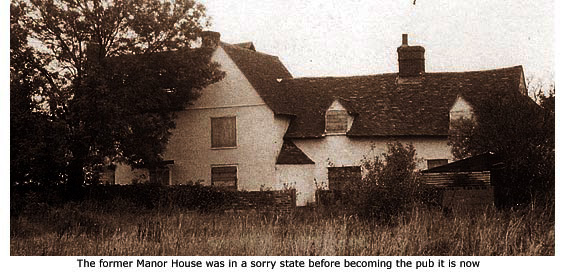
|
|
|
|
[ BACK TO TOP ] |
|
|
|
|
|
|
|




 Elizabeth and George Frere had two sons, both of whom would be remembered in later years for their accomplishments on the world stage and locally. Henry Bartle Frere (1815–1884) was to serve a long career in the Civil Service, becoming British colonial administrator of India and high commissioner in South Africa. For his part in the India Mutiny of 1857 he was rewarded with a knighthood and later, in South Africa, was connected with the abolition of the slave trade. He was also instrumental in provoking the Zulu war of 1878 which, though ending in victory for Britain, cost the country dear in lives and money. For his part in it, Sir Henry was officially censured. He died in Surrey in 1884.
Elizabeth and George Frere had two sons, both of whom would be remembered in later years for their accomplishments on the world stage and locally. Henry Bartle Frere (1815–1884) was to serve a long career in the Civil Service, becoming British colonial administrator of India and high commissioner in South Africa. For his part in the India Mutiny of 1857 he was rewarded with a knighthood and later, in South Africa, was connected with the abolition of the slave trade. He was also instrumental in provoking the Zulu war of 1878 which, though ending in victory for Britain, cost the country dear in lives and money. For his part in it, Sir Henry was officially censured. He died in Surrey in 1884. Ursula Frere went to Pretoria, South Africa, in 1946 to do missionary work, and Beryl Frere moved to nearby Latchmore Hall (Hallingbury Road), but on a return visit to see her sister in 1957, Ursula died. In the early 1970s Beryl Frere moved to sheltered accommodation in Dorking, Surrey, near to her sister Phillis, but later returned to Abbeyfield Nursing Home in Cricketfield Lane, Bishop's Stortford, where she died in 1975. She was the last member of the Raper/Grant/Frere family dynasty associated with Twyford House.
Ursula Frere went to Pretoria, South Africa, in 1946 to do missionary work, and Beryl Frere moved to nearby Latchmore Hall (Hallingbury Road), but on a return visit to see her sister in 1957, Ursula died. In the early 1970s Beryl Frere moved to sheltered accommodation in Dorking, Surrey, near to her sister Phillis, but later returned to Abbeyfield Nursing Home in Cricketfield Lane, Bishop's Stortford, where she died in 1975. She was the last member of the Raper/Grant/Frere family dynasty associated with Twyford House.
